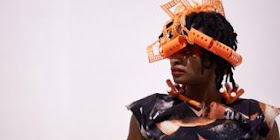 |
| Davalois Fearon wearing a costume from For C.J. |
Davalois Fearon Dance
For C.J.
BAAD!
March 29-30
When dance artist Davalois Fearon lost her nephew to asthma, she turned mourning into action. Her work, For C.J., represents a cry against the dire health outcomes for communities--predominantly, Black and Latinx people--doubly-impacted by urban pollution and inadequate health care. Fearon, a Jamaican immigrant who grew up in the Bronx, created The For C.J. Initiative to raise awareness and spur city policymakers to address these life-threatening conditions. But she also created a dance to honor her nephew, set to music played live at BAAD! by her husband, composer Mike McGinnis (wood winds), Elias Bailey (tuba) and Jeff Hermanson (trumpet). For C.J.'s resolute symbolism even carries over into instrumentation which requires expert and sustained use of breath.
Without careful reading of Fearon's program notes, it might be tricky to figure out at first look, but her performers represent not only an asthma victim (Mikaila Ware) but also the engulfing forces of her doom (Morgan Anderson, as the medical system, and Njeri Rutherford as the environment). The minute you grasp it, though, the symbolism feels heavy and obvious. All three are dressed in extraordinary wearable art--like hair-coverings made of whole and broken plastic hair rollers--and glittery makeup, blurring distinctions between high and low, pretty and poisonous. The set, unusual costuming give the work the heightened aura of tribal ritual.
The audience gets drawn in, too. Before the piece begins, we're invited to inscribe the names of deceased loved ones on cut-out leaves and tie the stems to ropes that play a significant part in this dance. Those leaves, then, will accumulate and remain for all future performances of the piece.
Like the visual display--including Ware's grotesque, bulbous headdress constructed of something mysterious and, frankly, nauseating--choreography alternates oddity with poignancy. We end with the vision of Ware's body folded forward in yoga's child's pose, covered in a glittery, earth-dark wrapping that now kills her.
To lift the energy, then, the choreographer and her dancers return to celebrate the life and spirit C.J. with the exuberance I remember of forceful, high-flying Fearon dancing for choreographer Stephen Petronio.
Concept, choreography and artistic direction: Davalois Fearon
Collaborating dancers: Morgan Anderson, Njeri Rutherford and Mikaila Ware
Costumes, wearable sculptures and makeup: Jasmine Murrell
Set Design: Myssi Robinson
For C.J. concludes this evening with an 8pm performance. For information, click here and scroll down.
BAAD!
2474 Westchester Avenue, The Bronx
(map/directions)
******
DISCLAIMER: In addition to my work on InfiniteBody, I serve as Senior Curatorial Director of Gibney. The postings on this site are my own and do not necessarily reflect the views, strategies or opinions of Gibney.
******








